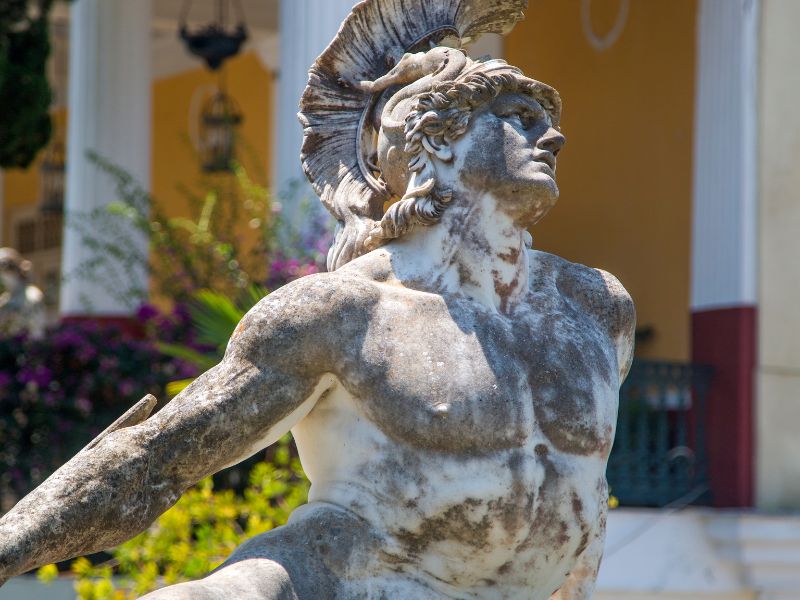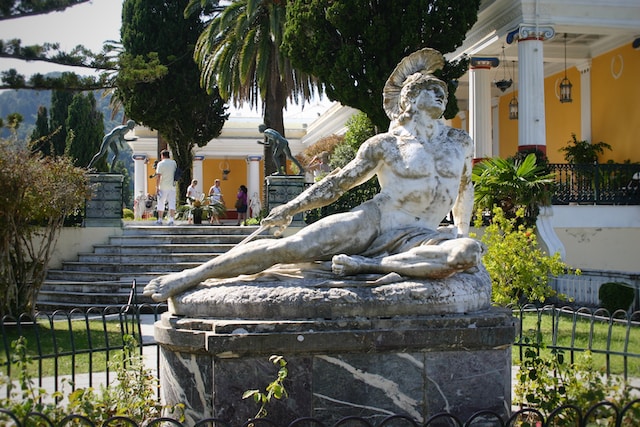The Dying Achilles in Achilleion Palace is a poignant marble masterpiece crafted by the skilled hand of acclaimed German artist, Ernst Herter. This exquisite work of art captures the tragic final moments of the legendary Greek hero, Achilles. The sculpture illustrates Achilles at the brink of death, having been fatally wounded by Paris, the Prince of Troy.
The hero’s muscular form is depicted in a vulnerable pose, an echo of his human frailty despite his storied invincibility. This captivating piece stands as a stark reminder of the tragic cost of war, resonating through the ages.
Table of Contents
Where is the Dying Achilles Statue
The Dying Achilles statue is prominently displayed in the Achilleion Palace, located in Gastouri, on the beautiful island of Corfu, Greece. Nestled amidst lush greenery and overlooking the glistening Ionian Sea, the palace houses many stunning pieces, with the Dying Achilles taking center stage in the palace gardens. It’s a sight that’s not to be missed by any visitor to the island.

Description of the Dying Achilles Statue
The Dying Achilles statue is a masterful evocation of the tragic mortality of one of Greek mythology’s most iconic heroes. Crafted from pure white marble, the figure of Achilles is rendered with exquisite precision, the breadth of his muscular form displaying Ernst Herter’s impeccable attention to detail.
Achilles is portrayed at his moment of greatest vulnerability, his body slumped and face etched with the pain of Paris’ fatal arrow. His left hand clutches at the Trojan arrow embedded in his heel – his only weak point, while his right hand weakly grasps a short sword, an emblem of the warrior’s indomitable spirit, even in the face of death.
Notwithstanding his formidable reputation as an invincible warrior, this statue represents a poignant contrast, underscoring the inescapable human frailty that even Achilles could not avoid. His body, though depicted in its full athletic vigour, is finally succumbing to the inevitability of mortality.
The sculpture’s raw emotion is heightened by Achilles’ prone position, his head bowed and his body collapsing to the earth, a stark allusion to his imminent demise.
Ernst Herter’s Dying Achilles is more than a sculpture; it’s a narrative masterpiece, presenting a compelling story of valour, vulnerability, and the ultimate tragedy of war.
Closely observed, one can almost feel the silent echo of Achilles’ last breath, a powerful testament to the enduring influence of Greek mythology and the timeless appeal of its heroes.

Ernst Herter: The Mind Behind the Dying Achilles Statue
Ernst Herter, a renowned German sculptor, is the artistic genius behind the creation of the Dying Achilles statue. Born in 1846 in Berlin, Herter was a prominent figure in German art during the late 19th century.
He received his formal training at the Prussian Academy of Arts, after which he embarked on a prolific career that would witness the creation of several notable sculptures, with the Dying Achilles standing out as one of his most significant works.
Herter was deeply inspired by Greek mythology and ancient classical art. The tale of Achilles, the invincible warrior who was ultimately felled by a single arrow to his heel, captured Herter’s imagination.
The paradox of Achilles’ invincibility and vulnerability presented a compelling narrative that Herter sought to express in marble.
The Dying Achilles statue is a testimony to Herter’s artistic vision as he successfully captured the hero’s strength, pain, and vulnerability in a moment frozen in time. His ability to convey this complex narrative through stone – palpable emotion, physical strain, and the tragic inevitability of death – marks the Dying Achilles as one of Herter’s most profound and memorable works.

The Legend of Achilles and Paris
The legend of Achilles and Paris is steeped in the rich tapestry of Greek mythology, and it forms a critical part of the epic tale of the Trojan War. It’s a story of destiny, deceit, and ultimately, death.
Achilles, the greatest Greek warrior, was gifted with invincibility by his mother, the nymph Thetis. She had dipped him in the River Styx, making him impervious to harm everywhere on his body, except for his heel, which she had held while immersing him in the magical waters.
Paris, the Prince of Troy, was far from a mighty warrior. He was, in fact, more known for his charm and good looks than his battlefield prowess. With the help of the goddess Aphrodite, he had ignited the Trojan War by abducting the beautiful Helen from her husband, the Spartan king Menelaus.
The fateful encounter between Achilles and Paris occurred towards the end of the Trojan War. Paris, guided by the sun god Apollo, struck an arrow at Achilles’ heel, the only vulnerable point on the Greek hero’s body. This single shot caused the invincible Achilles to meet his untimely end, immortalising the tale of his extraordinary life and tragic death.
Ernst Herter’s marble masterpiece, the Dying Achilles, encapsulates this poignant moment. It portrays the mighty Achilles in his last moments, felled by a prince known more for his love affairs than his martial skills. It’s a vivid reminder of the enduring power of Greek mythology, the complexities of its heroes, and the tragic consequences of war.
Dying Achilles Statue in a nutshell
- The Dying Achilles is a striking marble sculpture created by renowned German artist Ernst Herter.
- The piece portrays the legendary Greek hero, Achilles, at the point of death from a fatal wound inflicted by Paris, the Prince of Troy.
- Achilles is shown in a vulnerable state, his muscular body illustrating both the artist’s acute attention to detail and the hero’s inherent human frailty.
- He is captured in the throes of death, his left hand reaching for the arrow lodged in his heel, his only weak spot, whilst his right hand clings to a short sword, symbolising his enduring warrior spirit.
- Despite Achilles’ reputation for invincibility, the statue underscores the stark reality of human mortality, its powerful emotion emphasized by Achilles’ collapsing position and bowed head.
- The Dying Achilles is not merely a sculpture, but a storytelling masterpiece, encapsulating a story of courage, vulnerability, and the tragic consequences of war.
- Viewers are invited to an intimate reflection on the poignant final moments of Achilles’ life, an experience heightened by the tangible emotions and physical strain captured in the marble.
- Ernst Herter’s creation stands as one of his most profound and memorable works, embodying a complex narrative that continues to resonate with audiences.
Further Research
For those interested in further exploring the captivating world of Greek mythology, the tragic tale of Achilles, or the artistic genius of Ernst Herter, the following resources are recommended:
- The Iliad by Homer: This epic poem is the primary source for the story of Achilles, detailing his journey, his battles, and his tragic death. It provides an in-depth look at ancient Greek culture, wars, and heroes. Available in various translations, it can be read online at The Internet Classics Archive.
- The Trojan War: A New History by Barry Strauss: This book offers a comprehensive account of the real-world factors that might have inspired Homer’s Iliad. It sheds light on the historical aspects of the Trojan War and can be found at Amazon.
- Ernst Herter at the Art Renewal Center: This online gallery features several works by Herter, including the Dying Achilles. The gallery provides a detailed overview of his artistic style and contributions to the art world. Visit the Art Renewal Center.